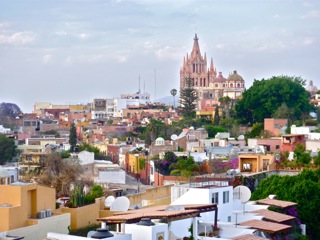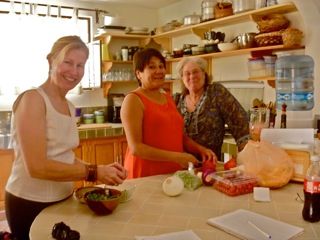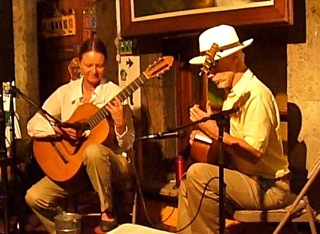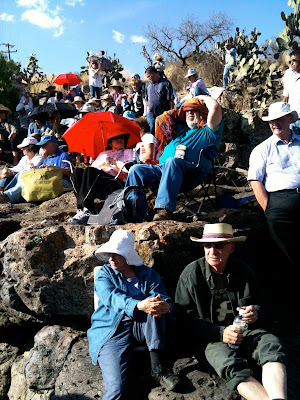Hola, everyone
As I write, the church bells are ringing and birds in my garden are chirping madly — they love to splash in the fountain. There are gentle white clouds in the sky but it's mostly sunny. It's been pretty warm these last couple of weeks, only in the 80s but the sun is very strong so it feels warmer. I've taken to walking with an umbrella, and at night we sleep with an overhead fan and a floor fan. We haven't been here in this season before, but I am told it starts getting warm in mid-March until the rains that start in June begin to cut the heat a bit.
Since I wrote last, I went to see Dido and Aeneas, an opera by Handel as part of the Baroque Music Festival, and the following day Rick and I, along with our friends Victor and Roberta, went to the final concert in the series. It was held outdoors in the canyon at the Botanical Park just outside of town. Such a thing would never, never, never,
never be allowed in the US. After a walk down a hillside, people were perched precariously on steep rocks, many near drops onto other rocks 50 feet below. Just think what the liability insurance would cost!
In the photo below is Roberta, with the red umbrella, and Victor, with the shawl to keep out the sun. They were on a rock a bit above us.
But it was an extraordinary scene:
And when the concert finally started, people watched monarch butterflies float through the canyon as they listened to the music. The musicians are wearing white shirts in the upper middle of the photo below.
Towards the end of the concert, some people were concerned about the twilight and started leaving early. When you consider that the footing for young people with perfect balance was pretty iffy — and the consequences of a fall on these rocks pretty frightening — it's amazing that so many people, including a
lot of older people, wanted to be there. I have to admit that I've done my canyon concert and see no need to go back again next year, especially because unless the wind was in the right direction, which it wasn't, it's hard to hear the music. But I'm so glad I did it.
I have two cooking lesson recipes to give you! On March 22 we made chicken molé and red Mexican rice. Yurina tells me that red rice is served in fiestas. For first, we made vegetable soup. These recipes are for 8.
Sopa de Verduras — Vegetable Soup
8 pieces chicken (used also for pollo con mole)
Salt
Potatoes
Zucchini squash
4 Carrots
1/3 small cabbage
Celery
Any other vegetables
2 ears corn on the cob, cut into 4 pieces
Lime
Onion
Serrano chilis
Tortillas
Wash chicken and remove all fat. Put in large pot with lots of water over high fire.
Add salt
Add half to one cup of diced onion
Add a large garlic clove
Skim scum from soup.
Add vegetables, hardest ones first (e.g. carrots)
Remove chicken when well cooked.
Cook soup another half hour.
Cut up small bowls of limes, Serrano chile (removing the veins reduces the spiciness), and diced onion to serve with soup when serving.
To serve, put one piece of corn in the center of soup bowl, add more vegetables, and broth.
Polle con Mole — Chicken with Mole Sauce
The same 8 pieces of chicken as for the soup
1 lb prepared mole sauce
A small piece of dark chocolate
Put mole in pot and add 4 ladles or more chicken soup from soup pot. Mash and stir it smooth. Add a small piece of chocolate. Stir nonstop (!) for 30 minutes.
When chicken is thoroughly boiled, remove from soup and put in mole pot. Cover with mole and let sit to absorb flavor for a little while.
Arroz Rojo — Red Rice
About 2 cups white rice (half a package!)
About ¼ to ½ cup fresh peas
4 roma tomatoes
¼ large onion
1 large clove garlic
2 large stems parsley leaves
2 tsp salt
3 carrots, diced
Olive oil
Boil peas in small pot about 40 minutes
Peel and cut tomatoes in pieces; liquefy in blender
Add onion, garlic, parsley and salt to blender; liquefy again
In large pot, add some olive oil. When hot, add rice and diced carrots. Stir until dark golden (rice for arroz rojo is cooked darker than for arroz blanco)
Pour in water to twice the height of rice, and add peas. Add a couple of ladles of chicken soup from the pot.
Pour in tomato mixture from blender.
Cook over low fire until rice is done to taste.
And the following week, which was Roberta's last (she's shared my cooking lessons all four weeks she's been here), we made cream of corn soup and pork in tomatoes. Again, recipe for 8.
Entomatadado de Puerco (Tomato mixture with Pork)
1.5 lbs green tomatillos
1 lb red tomatoes
2 lbs pork shoulder or other cut of pork
6 large cloves garlic
1 large onion
4 small-medium potatoes
1 small chipotle chile (canned is fine)
Parsley
Black beans
Put meat slices, with the bones, in a lot of water and cook until soft. If it’s fresh it will take 1 to 2 hours. Add four garlic cloves to the water.
Cut red tomatoes and tomatillos in small pieces. Put in large frypan and cook gently over small fire.
Cut potatoes in small pieces; dice onion; dice 2 cloves garlic.
When the tomatillos are starting to turn a duller green, add onion. Cook a little while and when the mixture is soft, add potatoes. Add the chile cut in very small pieces, and the diced garlic. Keep cooking over very low fire until potatoes are soft but not too soft: al dente. Stir occasionally and watch to see that it doesn’t burn.
Add salt to taste.
When the meat is soft, add to tomato mixture. If too soupy, allow liquid to evaporate; if too stiff, add water from meat pot.
Garnish with chopped parsley and serve warm. Also serve with black beans (frijoles negros) on the side.
Sopa de Crema de Elote (Cream of Corn Soup)
6 ears corn
½ liter milk
1 tbsp butter
A little dry rosemary, crumbled
Optional: dry sherry
If you’re making this with the entomatado de puerco, you can boil the ears of corn (shucked, of course) in the same pot as the meat.
When boiled, cut off the kernels. Reserve a small dish of kernels for garnish.
Put about a cup or more of kernels into the blender. Add 5-6 ladles of water from the meat/corn pot. Liquify. Pour this stuff into a wire mesh strainer over a large pot. Mash it down so that the cream of the corn goes into the pot and only the pulp is left in the strainer.
Put the pulp back into the blender and add another cup or so of kernels, with water from the pot. Repeat, putting all the accumulated pulp again into the blender, until the kernels are used up, and then do it a few times more to extract as much of the corn cream as possible. (You can save the pulp to make a corn pastry dessert with.)
Boil the soup gently, stirring constantly: it will thicken a little.
Add the milk and reheat.
Before serving, you can add just a little sherry, perhaps 3 tbsp for a large pot of soup, just to round off the taste – optional.
Garnish with corn kernels and serve hot.
I have learned that the left-over corn soup thickens considerably, which is terrific too.
And as always on our Tuesdays, we have a veritable salon going here for dinner. This past Tuesday Victor and Roberta Bremsons were here, as well as our friend Milt Fisher, who like the Bremsons went home at the end of March. With them were Mike Hatch, our current house guest (he left a few days ago) and our Mexican friends Gerardo and Magda. With 8 people, our table was full. I love Tuesdays: a party every week!
The chamber music series is winding down for the season. Last weekend we heard a marvelous pianist, Stephen Prutsman, doing an innovative program he had presented last fall at Carnegie Hall — for I'm sure 10 times as much money. He interspersed Bach preludes and fugues from Book 2 of the Well Tempered Clavier with other short pieces, modern and not so modern. I looked up the New York Times review afterward and saw that they had loved it too. Tomorrow night there's a classical guitarist, the last concert until the new series in October. I love these concerts, and for only100 pesos -- about $9.
Afterward, several of us went to dinner at San Miguel's chinese restaurant (!), which was actually very good. I met a woman there who used a memorable phrase to describe San Miguel. She called it "a fantasyland for people with a brain." Exactly right!
The following day we had a party at our house. If you are you saying, "So what's new?" you'd be right! The sister of Yurina, my cooking teacher, was visiting from Cuernavaca, and I invited the whole family over for lunch. Twelve of them came! Conversation was split between Spanish and English, and this family feels more and more like my own. I met Yurina through her brother, Gerardo, and I've met other family members through them both. Later in the week Yurina invited us over to her house for dinner, too -- she made pozole, which was delicious and which I will learn how to make and share with you. I feel very privileged to have these wonderful Mexican friends.
I have had my intermediate Spanish conversation class every day at noon at the Instituto Allende, and my Spanish is gradually, slowly, getting a little better. I can now occasionally — although not often! — use a verb in the past tense or the imperfect. The conditional is still beyond me. It's a challenge and I'm enjoying it. I'm also working hard on the adult education course I'm proposing to the Biblioteca. The Board meeting at which it will be considered and presumably voted on is two weeks from yesterday, April 15. I'm working on it with a friend here, Luba, and she and I have been amassing data. There is no competition, judging from a local website listing classes and course. The potential demand seems strong, judging from a survey Luba and I have done with about 80 people, and the budget indicates the Biblioteca would make some nice money from it while still keeping the course fee low. If all goes well, the first classes would start in October. I'll keep you posted!











































